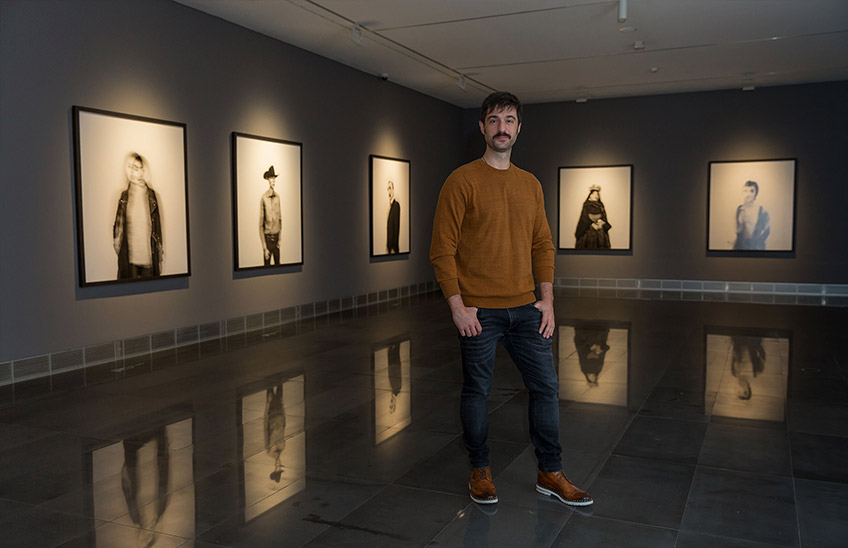Álvaro Laiz inaugurates 'The Edge' at MUN, a journey through time, territory and ancestors
The exhibition, the result of the artist's participation in the Museum's creation project Tender Puentes , can be visited from April 7 to October 2.

FotoManuelCastells/Artist Álvaro Laiz in one of the rooms of the exhibition 'The Edge' at the MUN.
07 | 04 | 2022
Time, territory and ancestors are the totems that Álvaro Laiz (León, 1981) explores in The Edgethe exhibition that opens this Thursday at the Museo Universidad de Navarra. The exhibition, which has been produced by the MUN, within the artistic residency project Tender Puentes, has the collaboration of the Science Museum of the University of Navarra and can be visited until October 2.
This work, on which he has been working since 2016, has led him to make different trips, from the Bering Strait to South America, a journey that will culminate soon in Tierra de Fuego, Argentine and Chilean territory. This geographical journey follows in the footsteps of the Paleo-Siberian populations that 20,000 years ago passed from Asia to America, becoming not only the first settlers of America, but also the ancestors of the peoples who later inhabited this territory.
Laiz, a National Geographic Storytelling Fellow since 2021, explains the origins of this in-depth work in which nature, traditional culture and technology converge "In Chukotka, I explored population genetics, a scientific discipline that deals with finding out the origins of human beings through DNA, by paternal and maternal groups. At that time, I was collaborating with National Geographic and contacted scientists and studies, based on the scientific literature about the populations that crossed the Bering Strait to America 20,000 years ago. At the same time, I conducted fieldwork on the Chukchi, a group that inhabits the Bering Strait and have a very land-bound way of life. One of the ways that struck me most was how they understand themselves in time. According to these traditions, one is not only one, but carries within oneself the ancestors". Thus, based on a dialogue between traditional culture and science, the various series that make up the exhibition emerged.
It takes its name, The Edge, "the edge" in English, from the Russian word kromka. "It is the place where the sea, ice and land meet, in a fairly fluid way. It is a hunting area for polar bears and also for humans. It's a contested place that is always changing, evolving, to refer to the migratory processes that come and go. They are not linear.
Valentín Vallhonrat, artistic director of the MUN together with Rafael Levenfeld, emphasizes that this work "brings together not only artistic disciplines but also many other forms of knowledge and representation that give rise to numerical and data series with which we are used to relating in fields other than art". Likewise, he has valued that it is a "very ambitious project, territorially immense, that has generated very different series, which address issues such as population genetics, migrations or the first populations that define the territories".
One of the series featured are the Relative Information portraits, taken of people from Russia and across America, and addressing key issues of the project by portraying people who have worked on it. "The captions make no reference to their name or profession. I use them as a kind of evocation that alludes to the geographic coordinates where that person and I crossed paths, the time span in which the image was taken, and the date. My intention is that the viewer, when confronted with both the portrait and the captions, participates in that encounter". The visitor could, for example, enter the coordinates in his or her cell phone and see the exact point where the photograph was taken.
In addition to photographic pieces, the exhibition also brings together video art and installation. For example, one of the pieces is a polyptych of 18 images made with the technique of transported charcoal (19th century). "The overall image is one of the first of Mars and is composed of small images, emulsified with pigments that I have been collecting in the journeys I have made," says the artist. In this exhibition, Laiz has kept in mind the work of artists from the Museum's Collection, such as De Launay, Napper, Laurent or Ortiz Echagüe: "I felt that I was also following in the footsteps of a tradition, of a lineage".
A SUSTAINABLE OUTLOOK
The exhibition is also closely linked to sustainability, with a parallel project called Beyond the Edgewhich has been accompanied by the consulting firm Ureculture. This initiative has been made possible thanks to the support of the National Geographic Society, Burroughs Wellcome Fund and the Museo Universidad de Navarra. "For example, the frames have been made with recycled material. With Ureculture we have worked on product issues to prepare a series of mock-ups to make them. We seek not only to talk about long-term thinking, but it invites us to rethink to do things differently. Art, sustainability and science all come together organically in the project."
The Museum also supports this parallel project that aligns with theUniversity of Navarra's Strategy 2025 focused on sustainability. As part of this support, a working group has been formed with members from other schools and faculties, and from the Strategy 2025 development team, which will analyze the Museum's impact within the time frame during which the exhibition can be visited in its galleries. This University and Museum project with the artist seeks to unite architecture, art and sustainability.